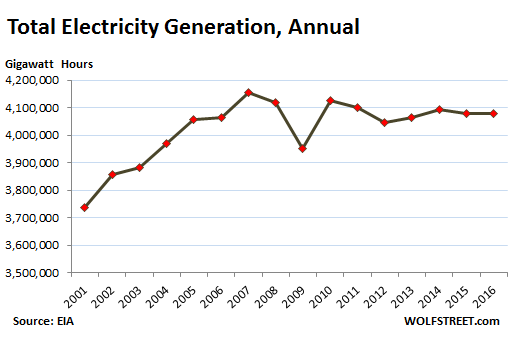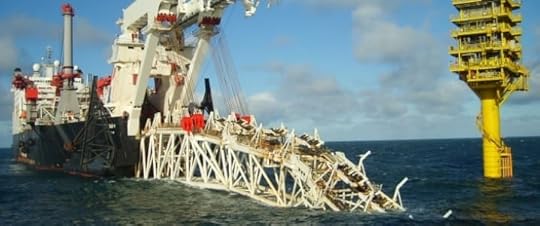Steve Bull's Blog, page 1239
December 4, 2017
Does the IEA try to hide the conventional crude oil peak in its 2017 World Energy Outlook?
In this post we look at crude oil production in the World Energy Outlook released in November 2017

Fig 1: WEO 2017 oil supply
Note that the 5 year interval table omits 2005 and 2010. Is this to conceal the 2005 conventional peak (see Fig 6)? The immediately important year 2020 also isn’t there.
Let’s put the crude oil related data of the above table 4.5 into a graph, thereby interpolating between 2016 and 2025 for 2020.

Fig 2: WEO 2017 crude oil
Production from existing conventional fields declines by around 4% pa to just 23.5 mb/d in 2040. Enhanced oil discovery, fields yet-to-be-approved and yet-to-be found are calculated in such a way that total conventional production does not decline much. The important message here is that it won’t grow. Only unconventional oil is assumed to bring growth in production.
Traditionally, the IEA calculated the “call on OPEC” as a balancing item between demand and Non-OPEC production. Maybe that call is no longer heard.
In Fig 2, the underlying methodology is more complex:
Show perpetual production growth to match assumed demand growth
Determine decline in existing fields
Add enhanced oil recovery
Add yet-to-be developed
Add yet-to-be found so that conventional production declines only marginally or looks rather flat
Stack on top growing tight oil and heavy oil to show overall growth
Let’s compare WEO 2017 with WEO 2016

Fig 3: Crude production forecast in the WEO 2016
We can see that the WEO 2016 was more detailed on existing fields. It showed post peak oil fields (70%), legacy fields (10 %) and ramp-up fields (20 %).

Fig 4: Comparison existing fields WEO 2017 -2016
In the above stacked clustered graph we see that “existing fields” in the WEO 2017 are lower and therefore decline is higher (up to 2025) than the 4 categories of the WEO 2016 report: post peak, legacy, ramp-up and approved-not producing plus enhanced oil recovery (EOR).
…click on the above link to read the rest of the article…
What Life Is Like for a Million People in Puerto Rico Who STILL Don’t Have Power
If you ever wondered what it would look like if the grid collapsed here on the mainland, the island of Puerto Rico is a tragic, real-life case study. These stories show us what life is like for more than a million people who STILL don’t have power and running water nearly 3 months after Hurricanes Irma and Maria devastated their communities.
According to a website showing the status of utilities on the island, four months after two hurricanes wrought havoc, 32% of Puerto Ricans are still without power and nearly 10% are still without running water. However, even those who have running water must boil it.
But statistics don’t tell the real story.
At first, it was a war zone.
In the first days after the grid went down, chaos ruled. I vetted as many of the stories as I could and concluded:
…there is very little food, no fresh water, 97% are still without power, limited cell signals have stymied communications, and hospitals are struggling to keep people alive. There is no 911. Help is not on the way. If you have no cash, you can’t buy anything. As people get more desperate, violence increases. (source)
A friend wrote this post about her family on Puerto Rico:
“My family has lost everything. My uncle with stage 4 cancer is in so much pain and stuck in the hospital. However, conditions in the island are far worse than we imagined and my greatest fear has been made reality. The chaos has begun. The mosquitos have multiplied like the plague. Dead livestock are all over the island including in whatever fresh water supplies they have.
…click on the above link to read the rest of the article…
December 3, 2017
Paul Tudor Jones: “This Market, Which Is Reminiscent Of The 1999 Bubble, Is On The Verge Of A Significant Change”
Just hours after Neil Chriss announced that his $2.2 billion Hutchin Hill hedge fund is shuttering due to underperformance and admitted that “we fought hard, but did not deliver the performance that you expected from us”, another legendary hedge fund announced it was undergoing a significant restructuring as a result of relentless investor withdrawals: citing a November 30 letter, Bloomberg reported that Paul Tudor Jones’ Tudor Investment Corp, which lost 1.6% YTD, was closing its Discretionary Macro fund “and letting investors shift assets to the main BVI fund as of Jan. 1” with the letter clarifying that “Jones will also principally manage Tudor’s flagship BVI fund, which will be the firm’s only multi-trader fund next year.”
The restructuring took place as clients pulled half a billion dollars from Tudor in the third quarter, leaving the firm’s assets at $7 billion, roughly half the level it managed in June 2015, Bloomberg News reported previously. As part of the sweeping overhaul, Andrew Bound and Aadarsh Malde, formerly co-CIOs of the Tudor Discretionary Macro Fund, would depart. In a move reminiscent of George Soros’ recent return to more active management, Jones, who ran the BVI fund with a team of managers, would now have a smaller team and will assume a more dominant role in the fund.
“I will be the largest risk taker and will manage a notional capital account equal to the AUM of the Tudor BVI strategy itself,” Jones said in the letter, referencing assets under management. “This means that my results will have a one-for-one performance impact on Tudor BVI. I relish this challenge.”
Jones and other Tudor partners are the largest investors in the BVI fund, which unlike the soon to be shuttered TIC, is up 0.8% through Nov. 3. More details from Bloomberg:
…click on the above link to read the rest of the article…
Human well-being, economic growth and so-called decoupling
Some people claim that humans—called breatharians—can live on air alone. Others claim we can have economic growth without increasing our resource use, so-called decoupling. Neither claim withstands scrutiny though here I am only going to deal with the second one.
Hidden beneath the claim of decoupling is the assertion that human well-being and economic growth are synonymous. But, human well-being is far from a one-dimensional economic variable linked unalterably to more income and consumption. So, saying that economic growth must at some point come to an end to maintain the habitability of the planet is not the same as saying that human well-being must also stop improving.
On the contrary, a stable society in harmony with the workings of the natural world in a way that maintains the habitability of the biosphere for humans would seem to be an essential characteristic of a society which offers a high degree of well-being to humans. Destroying that habitability through endless economic growth then is contrary to human well-being in the long run.
All of this should seem obvious. But so often the advocates of growth or “sustainable” growth tell us that ending growth would destroy the chance for countless people to attain well-being in our modern industrial world. While that has some truth within the narrow context that measures well-being as a function of economic output, it misses the point above. An uninhabitable world is really, really bad for human well-being.
The answer these advocates say is economic growth decoupled from increased resource use. But as two recent papers suggest, this is an oxymoron.
As “Is Decoupling GDP Growth from Environmental Impact Possible?” explains,while society has been getting gradually more efficient at producing goods and services, we are not anywhere near economic growth without increased resource use. The apparent decoupling in Germany and some other countries is probably due to the following factors:
…click on the above link to read the rest of the article…
The Reader’s Choice Survival and Preparedness Library
Last week, I showed you the list of my personal favorite preparedness books and asked you for your favorites. Many of these, I hadn’t heard of, while others, I just hadn’t read or overlooked. But what we have here is an amazing list of books to add to your survival and preparedness library.
For some, I was able to provide links so that you can get them. Others weren’t as easy to find, but you can be on the lookout for them when you hit thrift stores, libraries, and yard sales. The listings below all have the reasons that the reader recommended them.
Happy reading!
The Reader’s Choice Survival and Preparedness Library – Non-Fiction
General Preparedness
The LDS Preparedness Manual (Note: If you aren’t looking for a hard copy, you can download it free at this link.)
Just in Case
Survival Theory: A Preparedness Guide
How to Survive the End of the World as We Know It
The Prepper’s Pocket Guide: 101 Easy Things You Can Do to Ready Your Home for an Emergency
How to Prepare for Most Emergencies on a $50 a Month Budget
US Army FM 21-76 Field Survival Manual
Boy Scout Handbook
Food
The Foragers Harvest
Stocking Up
The Resilient Gardener: Food Production and Self-Reliance in Uncertain Times
Sonoran Desert Food Plants
Southwest Foraging: 117 Wild and Flavorful Edibles from Barrel Cactus to Wild Oregano
Foraging the Rocky Mountains
Foraging New England
(If your region isn’t listed here, I strongly recommend you search for a local guide to foraging)
Health
Encyclopedia of Herbal Medicine
Herbal Recipes for Vibrant Health
The Bathroom Key
Essential Oils Natural Remedies
PDR for Herbal Medicines
Herbal Medicine for Pets
EMT textbook (Very expensive but potentially great information)
Herbal Antibiotics
Medicinal Plants of the American Southwest
Self-sufficiency
…click on the above link to read the rest of the article…
How the U.S. Dictatorship Works

How the U.S. Dictatorship Works
A recent article in the Washington Post described how the current US tax-‘reform’ bill is being shaped; and it describes, basically (at least as far as tax-law changes are concerned), the operation of a US dictatorship by the super-rich.
First of all, however: there is no longer any realistic question as regards whether the US in recent decades has been a dictatorship, or instead a democracy. According to the only scientific analysis of the relevant data, that has been done in order to determine whether the US is a dictatorship or a democracy, the US is definitely a dictatorship that’s perpetrated by the extremely richest, against the public-at-large; in other words: the US Government functions as an aristocracy, otherwise referred-to as an oligarchy, or a plutocracy, or a kleptocracy; but, in any case, and by whatever name, it’s ruled by a tiny number of the extremely wealthiest and their agents, on behalf of those few super-rich, against the concerns and interests and needs of the public (everyone else). So: instead of being rule by the public (the “demos” is the Greek term for it), it’s rule on behalf of a tiny dictatorial class, of extreme wealth — by whatever name we might happen to label this ruling class.
That study, by professors Gilens and Page, explained that it examined “1,779 instances between 1981 and 2002 in which a national survey of the general public asked a favor/oppose question about a proposed policy change,” and it compared those public-policy preferences, by the public, versus the public-policy preferences regarding those same issues, by the super-wealthiest; and, it found that only the public-policy preferences by the super-wealthiest and their paid agents, made any discernible difference, at all, in the likelihood that a given public policy ultimately became enacted into law, in the United States.
…click on the above link to read the rest of the article…
Is Cryptocurrency a Government Plot?
QUESTION: You have said that the future will be cryptocurrencies. The Bank of Canada has come out and acknowledged what you have been saying that such private issue challenges the government’s profit structure. Do you think electronic money will be viable sooner or later down the road?
PG
ANSWER: Electronic currency is ALREADY the bulk of the money supply. When you deposit $100 in a bank, it lends out $90 from your deposit and your bank statement still reflects you have $100. However, the person who borrowed the money now has $90 in their account. The government did not “print” money to cover that extra $90, rather they just created “electronic” money.
So what is the big thing about cryptocurrencies? The idea is that it is money that will not depreciate and is strangely not “fiat.” Yet, it is no different than the electronic money created by the bank, which is also outside the strict domain of government.
If you just look at the price of Bitcoin, it demonstrates that this is merely a speculative boom indistinguishable from the Dot.COM Bubble, which also reflected a new era in technology. If Bitcoin was truly an alternative currency that was supposed to retain its value, the mere fact that the rice has soared like any stock proves that it is by no means a “store of wealth” that somehow is better than currency in which it must still be converted to use in the bulk of the economy.
If the power grid failed, everyone would be broke. You could not even buy food. Society would revert immediately back to barter. There are risks to any form of electronic money be it a bank or crypto. The government WILL move toward cryptocurrencies THAT THEY WILL CONTROL, not the private sector. I have stated before, they argue electronic money eliminates cash crime from bank robberies, drugs, prostitution, etc., but it introduces more sophisticated hacking computer crimes.
…click on the above link to read the rest of the article…
US Demand for Electricity Falls Further: What Does it Mean?
Layoffs at GE Power, for example.
The weekend started Friday night with layoff news from GE’s power division, in two locations.
First, there was Greenville County, South Carolina, where GE Power is one of the largest employers with 3,400 workers.
“Based on the current challenges in the power industry and a significant decline in orders, GE Power continues to transform our new, combined business to better meet the needs of our customers,” GE’s statement said in flawless corporate speak: “As we have said, we are working to reduce costs and simplify our structure to better align our product solutions, and these steps will include layoffs.”
GE Power has not disclosed the number of workers that are part of this layoff. The facilities make large gas turbines and turbine generator sets used by power plants. The plant also makes wind turbines.
Then there was GE Power’s facility in Schenectady, New York, which announced the layoff of an undisclosed number of employees, blaming “a significant decline in orders.”
GE Power has a problem: Electricity consumption in the US peaked in 2007 and has declined since, despite population growth of about 24 million people over the 10 years and despite economic growth.
The chart below, based on data from the Department of Energy’s EIA, shows annual electricity generation from 2001 through 2016. Note the growth in generation through 2007, the plunge during the Financial Crisis, the recovery, and the uneven decline since:

This trend continues in 2017. On Friday, the EIA released its Electric Power Monthly, with power generation data through September 2017. Over these nine months, electricity generation has fallen by 2.6% compared to the same period a year ago. Part of the year-over-year drop in August and September was due to the damaged electric grid in the areas affected by Hurricanes Harvey and Irma.
…click on the above link to read the rest of the article…
Cherry-picking Toward War with Iran
In trying to rally American hostility toward Iran, CIA Director Pompeo and other U.S. officials are engaging in the same kind of distorted intelligence that led to the catastrophic Iraq invasion, writes ex-CIA analyst Paul R. Pillar.
Although nobody knows exactly where Donald Trump intends to go with his campaign of seeking confrontation with Iran, his administration already has provided disconcerting parallels with the techniques an earlier U.S. administration used in selling its launching of a war against Iraq. Among these techniques is the cherry-picking of intelligence not to inform policy-making or to enlighten the public but instead to inculcate false perceptions among the public and thereby to muster support for a policy already chosen.

Now CIA Director Mike Pompeo speaking at the 2012 CPAC in Washington, D.C. February 2012. (Flickr Gage Skidmore)
The parallels have become remarkably close as the Trump administration has tried to get people to believe there is some sort of cooperation and common purpose between Iran and Al Qaeda. The President made this insinuation in his speech on Iran in October. Then his CIA director, Mike Pompeo, ordered a tendentious re-exploitation of already exploited documents captured in the raid at Abbottabad, Pakistan, that killed Osama bin Laden.
This time the purpose was to find any possible connection between bin Laden’s group and Iran. Pompeo took the highly unusual step of giving an advance look at the selected documents to an advocacy organization: the Foundation for Defense of Democracies (FDD), a leader of efforts to kill the agreement that limits Iran’s nuclear program.
…click on the above link to read the rest of the article…
Nord Stream 2 Pipeline Becomes Less Plausible

A U.S. diplomat has dismissed the idea that the controversial Nord Stream 2 pipeline will ever be built.
Speaking to European journalists in a telephone briefing on November 29, Deputy Assistant Secretary of State John McCarrick said that U.S. officials “don’t see the possibility that Nord Stream 2 can be built.”
“That is not something we are going to assume is going to happen,” said McCarrick, who works at the State Department’s Bureau of Energy Resources.
When pressed for details, McCarrick responded that “there is a variety of reasons why it shouldn’t happen…. The bottom line is we are against this. We don’t see this happening, so why would I entertain any other sort of option or possibility?”
Earlier this year, the United States introduced sanctions that call for penalties against European companies that participate in the Nord Stream 2 and other Russian energy projects in Europe.
If built, the pipeline will run under the Baltic Sea from Russia to Germany, bypassing several European transit countries. It is scheduled to be completed by 2019.
Berlin has so far supported the pipeline, which would deliver 55 billion cubic meters of gas a year to Germany from Russia.
Several EU members in Central and Eastern Europe have expressed concern that the project would strengthen Moscow’s hand by increasing European reliance on Russian natural gas.
They have also voiced concern that it would reduce gas-transit revenues for Ukraine, damaging the country’s fragile economy at a time when its forces are fighting Russia-backed separatists who control part of two eastern provinces.






